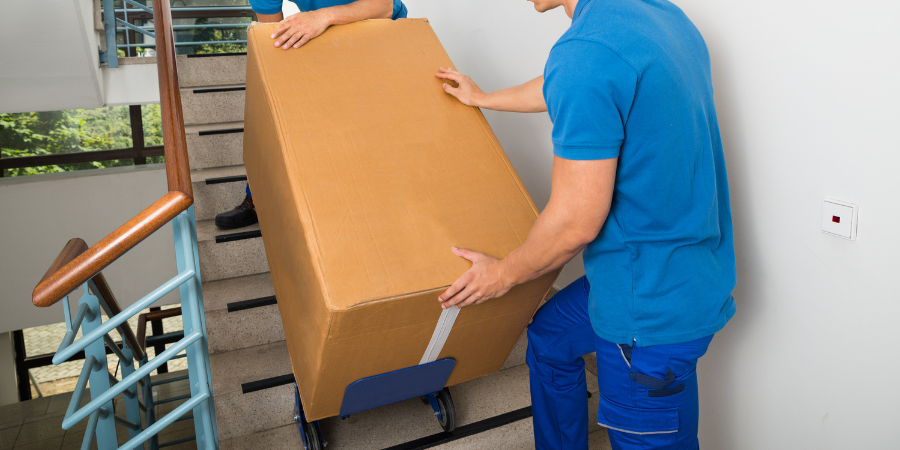
Moving into a building with no elevator can be a real test of patience and strength. The thought of lugging heavy furniture and endless boxes up flights of stairs may feel overwhelming. With the right planning, smart techniques, and moving equipment—like a hand truck rental or stair dolly—you can make this move much easier. In this guide, we’ll cover 10 essential tips to help you tackle the no-elevator challenge with ease.
1. Start with a Solid Plan
Moving to a walk-up requires a bit more forethought. Start by making a simple plan with a timeline, a task list, and some strategies for handling the stairs. Think about things like how to move a washer and dryer upstairs, the weight of your furniture, and the layout of the stairwell. Start by making a simple plan with a timeline, a task list, and some strategies for handling the stairs.
2. Declutter Before You Move
This is the perfect time to streamline your belongings. The less you have to carry up those stairs, the easier and faster your move will be. Go through your items carefully and decide what to keep, donate, or discard. Reducing what you’re moving means fewer trips up the stairs, saving you time, effort, and energy.
Plus, starting in your new home with a decluttered space can make it feel more refreshing, organized, and welcoming.
3. Measure Everything Beforehand
Measure all of your furniture and large items, along with doorways, stairwells, and landings, to make sure everything fits. Buildings without elevators often have narrow staircases. Getting a couch or dresser around tight corners can be challenging. Having measurements ready allows you to plan how to best maneuver large pieces without damaging walls or door frames.
4. Use the Right Packing Techniques
Packing efficiently is even more crucial when you’re moving into a building with no elevator. Pack your belongings in smaller, sturdy boxes to avoid overly heavy loads on each trip. Label each box clearly with its contents and destination room for quick organization at the new place.
Consider using backpacks or duffel bags for smaller items, as they can be easier to carry up stairs. You may also want to rent a hand trolley or dolly for stairs to help transport items safely.
5. Disassemble Large Furniture
To make things easier, disassemble items wherever possible. Remove table legs, take apart bed frames, and separate shelves from bookcases. Making each load lighter helps you handle furniture more easily and lowers the risk of damage to your items and the building. Keep screws and small parts in labeled bags so that reassembly is a breeze.
6. Enlist Professional Movers with the Right Equipment
For a move like this, hiring experienced heavy item movers can be worth the investment. Professional movers have the right skills, equipment, and techniques to handle heavy and awkward items up stairs safely. Let your moving company know about the lack of an elevator. They’ll come prepared with a stair dolly, hand truck rental, or even a pallet jack rental for heavy items.
7. Take Breaks and Stay Hydrated
Carrying boxes and furniture up several flights of stairs can be exhausting. To avoid fatigue and prevent injuries, take regular breaks and stay hydrated.
Keep a cooler with water and snacks nearby to stay energized throughout the day. Keep in mind that moving is a long process, requiring steady pacing and endurance. Pacing yourself will help you finish the day safely and successfully.
8. Coordinate with Your Neighbors
A little courtesy goes a long way in a walk-up building. Moving can be noisy and disruptive, especially when you’re occupying the stairwell for extended periods. Let your neighbors know ahead of time about your moving day plans, and try to schedule the move during off-peak hours. Being considerate of others helps create positive relationships in your new home.
9. Protect Your Belongings and the Building
Moving into a building without an elevator raises the risk of bumps and scrapes on your belongings and on the building. Use moving blankets to wrap your furniture and protect walls, railings, and floors. Be extra cautious around tight corners and narrow doorways. By protecting your belongings and the building, you can avoid repair costs.
10. Plan for Post-Move Recovery
A move into a walk-up building can be physically taxing, so plan for some recovery time afterward. Treat yourself to a hot bath, a massage, or even a relaxing day at home. Moving takes hard work, especially with stairs involved, so make time to unwind and recharge in your new space.
Conclusion: Conquer Your Walk-Up Move with Confidence
Moving to a building with no elevator may seem overwhelming, but with the right approach, you can handle it with ease. Follow these essential tips: plan carefully, measure ahead, pack smartly. Also consider moving equipment like hand truck rentals or stair dollies. Take care of your belongings, coordinate with neighbors, and take breaks.
These steps will help you have a smooth and stress-free move into your new home. Good luck, and welcome to your new place!









